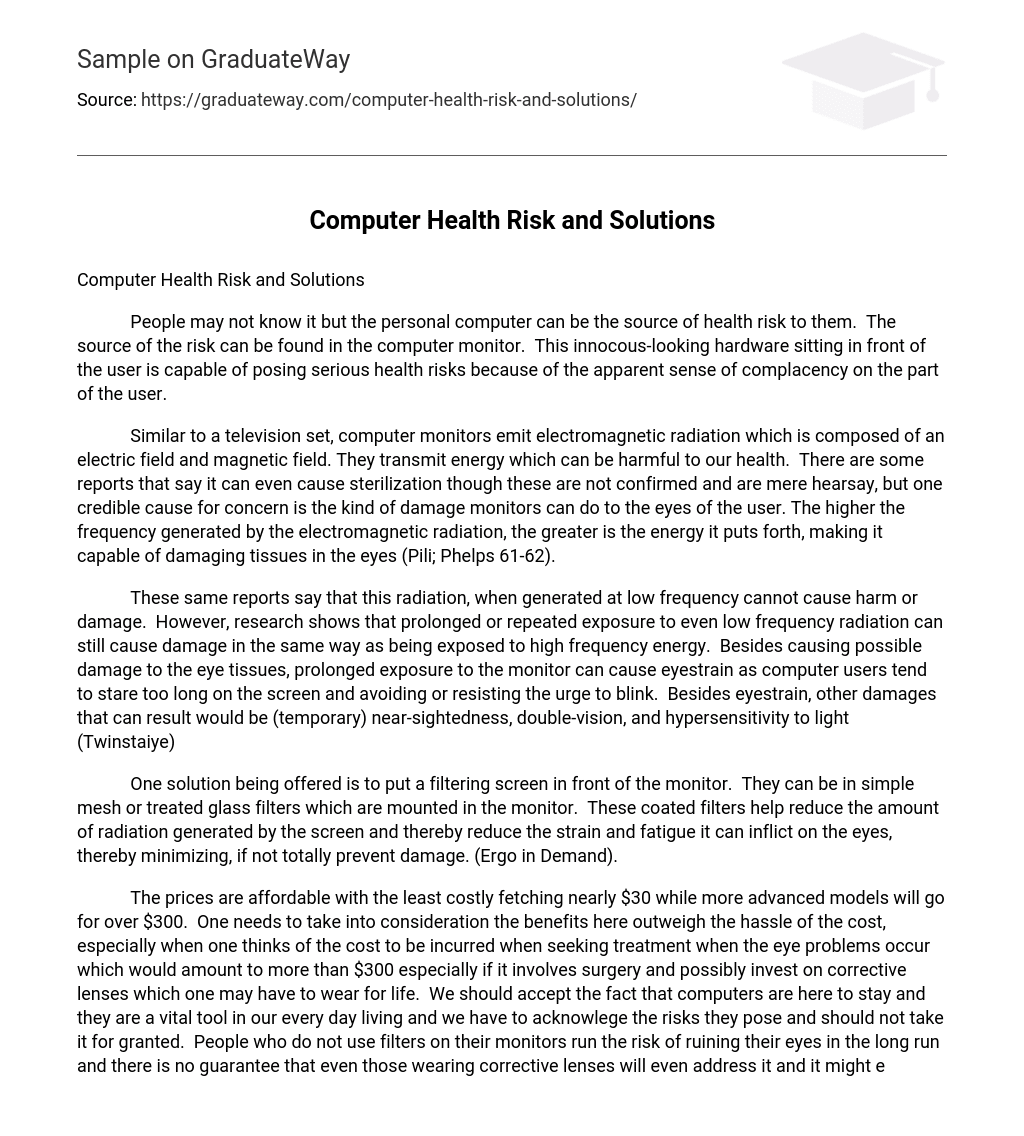People may not know it but the personal computer can be the source of health risk to them. The source of the risk can be found in the computer monitor. This innocous-looking hardware sitting in front of the user is capable of posing serious health risks because of the apparent sense of complacency on the part of the user.
Similar to a television set, computer monitors emit electromagnetic radiation which is composed of an electric field and magnetic field. They transmit energy which can be harmful to our health. There are some reports that say it can even cause sterilization though these are not confirmed and are mere hearsay, but one credible cause for concern is the kind of damage monitors can do to the eyes of the user. The higher the frequency generated by the electromagnetic radiation, the greater is the energy it puts forth, making it capable of damaging tissues in the eyes (Pili; Phelps 61-62).
These same reports say that this radiation, when generated at low frequency cannot cause harm or damage. However, research shows that prolonged or repeated exposure to even low frequency radiation can still cause damage in the same way as being exposed to high frequency energy. Besides causing possible damage to the eye tissues, prolonged exposure to the monitor can cause eyestrain as computer users tend to stare too long on the screen and avoiding or resisting the urge to blink. Besides eyestrain, other damages that can result would be (temporary) near-sightedness, double-vision, and hypersensitivity to light (Twinstaiye)
One solution being offered is to put a filtering screen in front of the monitor. They can be in simple mesh or treated glass filters which are mounted in the monitor. These coated filters help reduce the amount of radiation generated by the screen and thereby reduce the strain and fatigue it can inflict on the eyes, thereby minimizing, if not totally prevent damage. (Ergo in Demand).
The prices are affordable with the least costly fetching nearly $30 while more advanced models will go for over $300. One needs to take into consideration the benefits here outweigh the hassle of the cost, especially when one thinks of the cost to be incurred when seeking treatment when the eye problems occur which would amount to more than $300 especially if it involves surgery and possibly invest on corrective lenses which one may have to wear for life. We should accept the fact that computers are here to stay and they are a vital tool in our every day living and we have to acknowlege the risks they pose and should not take it for granted. People who do not use filters on their monitors run the risk of ruining their eyes in the long run and there is no guarantee that even those wearing corrective lenses will even address it and it might even aggravate it if the lenses are not specially treated.
The use of the filtering device should address this problem so as to ensure a less hazardous computing environment whether at home or in the workplace. Although preventive measure are also suggested, it is still a good investment to have a filter since computing is now a regular human activity and it is unavoidable that we would spend most of the time looking at the screen.
Works Cited
Ergo in Demand. “Monitor Filters – Anti Glare Screen, Anti-Radiation and Anti-Static.” Ergo in Demand.com. 2010. Retrieved 16 July 2010 <http://www.ergoindemand.com/Hanging- Mount.htm>.
India InfoTech. “Safe Computing Tips.” India Infotech.com. 1999. Retrieved 16 July 2010 <http://www.india-infotech.com/Articles/safe_computing.html>.
Phelps, Alan. “PC Health Hazards.” Computing Basics 11.6 (June 2000): 61-62.
Pili, Unofre. “Health Watch: Health Hazards of Computer Monitors and How to Avoid Them.” Health Mad.com. September 21, 2008. Retrieved 16 July 2010 <http://healthmad.com/conditions-and-diseases/health-watch-health-hazards-of-computer-monitors-and-how-to-avoid- them/>.
Twinstaiye. “Eye Hazards and Computer Monitor.” Hazardous. 2007. Retrieved 16 July 2010 <http://hazardouss.wordpress.com/2007/02/13/eye-hazards-and-computer-monitor/>.





